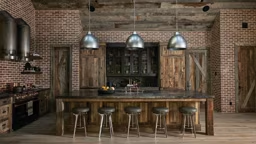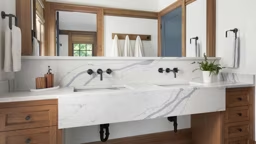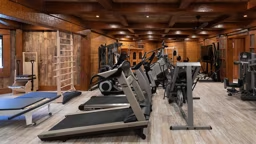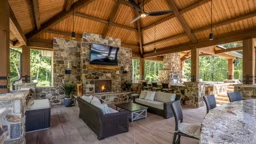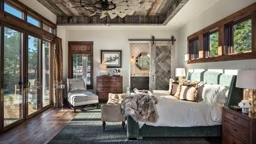
No matter the size of your timber home, the main level is where you’ll live most. And although you’ll spend plenty of time in the great room and sitting areas, don’t be surprised if you find yourself being drawn to the kitchen and eating spaces time and time again. Because of this frequent use, these highly functional spaces should be planned to near perfection. Here’s how:
KITCHEN CONSIDERATIONS
The most important ingredients for a successful timber frame kitchen are the elements of the work triangle: the refrigerator, sink and range. To optimize efficiency, the sum of the sides of the triangle should total no more than 26 feet, with no single leg of the triangle measuring less than 4 feet. For adequate prep space, you should aim for 158 total square inches of countertop in your timber frame kitchen.
The standard height for countertops is 34 to 36 inches above the floor, and the standard depth is 24 inches, but this can vary based on your size, preferences, appliance depth and the details of your backsplash. In terms of prep space, try for at least 12 inches of counter space on at least one side of your stovetop and your refrigerator. Also remember that the walking space between countertops should be at least 48 inches wide but not more than 64 inches apart.
You don’t want your space so spread out that you actually lose efficiency during meal preparation. Keep in mind that an island might contribute to the total countertop space in your timber frame kitchen. If you plan to use your island for prep space, the size of the island should be a minimum of 3-by-4 feet. If you plan to use it more for seating purposes, the perimeter of the island should allow for 24 inches per person. Where you’re cooking and cleaning, you’ll want to design your space with a minimum of 42 inches between all permanent structures, such as the countertops and the island.
If two or more cooks are regularly together in the kitchen, you’ll probably want to bump that space up to 48 inches. For safety purposes, make sure that your layout allows for the correct operation of each appliance (e.g., no door obstructions). You’ll also need to plan your cabinetry well. The distance from your countertop to your upper cabinets should be 15 to 20 inches. (Any lower and you’ll impede your work space; any higher and it could be tough to reach your highest shelves.) As for the rest of your storage needs, designers recommend at least 18 square feet of general storage. Tack on another 6 square feet for each additional family member.
DINING CONSIDERATIONS
Although formal dining rooms are becoming less common in today’s homes, most people like to incorporate a space that’s designated for sit-down meals. Whether you’re planning a casual eat-in area that's attached to your timber frame kitchen or a more conventional dining space, it’s incredibly important that the room size and shape work properly with the furniture you plan to use, especially if traffic will need to pass behind seated diners.
You’ll need to design a room that will allow for at least 44 inches around the perimeter of the table to walk by comfortably. On the other hand, if you’re planning a cozier space where guests will simply need to edge past people’s chairs, you can minimize that space to 36 inches. When it comes to the dimensions of your table, plan to provide 2 feet of space per person.
For example, if you plan to host a total of eight people at a time, you’ll need a table with at least a 16-foot perimeter. Avoid dining tables wider than 48 inches. Any wider, and diners will need to stand up from their chairs to pass dishes across the table. As far as other crucial measurements, try not to place additional furniture items (think china cabinets and chests of drawers) closer than 2 feet apart. Also, if you’re working with wood floors and planning to put down a rug underneath your table, make sure to buy a rug that is at least 2 inches wider in each direction than the top of the table when all the leaves are in place. And, if you’re creating a separate dining room (rather than a space that’s part of a larger living area), make sure to design an entryway that’s at least 42 inches wide to provide ample walking room.
Information courtesy of the National Kitchen & Bath Association and Design Works.




